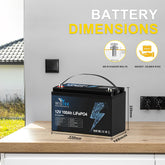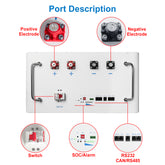¿Cuál es la vida útil de las baterías de las luces de emergencia?
Comprender la vida útil de las baterías de las luces de emergencia es crucial para garantizar la seguridad y la fiabilidad durante cortes de energía o emergencias. Las luces de emergencia dependen en gran medida de sus baterías para funcionar eficazmente cuando falla la fuente de alimentación principal. Conocer la duración de estas baterías ayuda a planificar los programas de mantenimiento y los ciclos de reemplazo. En este artículo, exploraremos los factores que influyen en la vida útil de las baterías , los tipos de baterías que se utilizan en las luces de emergencia y consejos para prolongar su vida útil.
- Factores que afectan la vida útil de las baterías en las luces de emergencia
- Tipos de baterías utilizadas en luces de emergencia y su vida útil
- Cómo prolongar la vida útil de las baterías de las luces de emergencia
- Señales de que las baterías de las luces de emergencia están llegando al final de su vida útil
- Mejores prácticas para reemplazar las baterías de las luces de emergencia
- Impacto de la vida útil de la batería en la confiabilidad de la luz de emergencia
- Tecnologías emergentes para mejorar la vida útil de las baterías en la iluminación de emergencia
Factores que afectan la vida útil de las baterías en las luces de emergencia
La química de las baterías y su impacto en su vida útil
La vida útil de las baterías depende en gran medida de su composición química. Los tipos de baterías más comunes en los sistemas de iluminación de emergencia son las de plomo-ácido, níquel-cadmio (NiCd) y de iones de litio. Cada tipo tiene características distintivas que influyen en su longevidad.
Baterías de plomo-ácido : tradicionales y rentables, pero tienden a tener una vida útil más corta, de entre 3 y 5 años.
Baterías de níquel-cadmio : más duraderas, con una vida útil de entre 5 y 7 años, pero sufren efecto memoria si no se mantienen adecuadamente.
Baterías de iones de litio : cada vez más populares debido a su mayor vida útil de 8 a 10 años y su mejor densidad energética.
Patrones de uso y ciclos de carga
La forma en que se usan y cargan las baterías de las luces de emergencia influye en su vida útil. Las descargas frecuentes, la carga incorrecta y los largos periodos sin uso pueden reducir la vida útil de la batería. Mantener una rutina regular de pruebas y carga es esencial para maximizar su vida útil.
Condiciones ambientales
La temperatura, la humedad y la exposición a entornos hostiles pueden degradar las baterías más rápidamente. Las altas temperaturas aceleran las reacciones químicas en su interior, lo que provoca pérdida de capacidad, mientras que el frío extremo puede reducir temporalmente su eficacia.
Tipos de baterías utilizadas en luces de emergencia y su vida útil
Baterías de plomo-ácido
Las baterías de plomo-ácido son las más utilizadas en la iluminación de emergencia debido a su asequibilidad y disponibilidad. Su vida útil suele ser de 3 a 5 años, pero puede acortarse si la batería se descarga profundamente con frecuencia o se expone a altas temperaturas.
Baterías de níquel-cadmio
Las baterías de níquel-cadmio ofrecen una mayor vida útil que las de plomo-ácido, generalmente de 5 a 7 años. Sin embargo, requieren un mantenimiento adecuado para evitar el efecto memoria, que puede reducir su capacidad con el tiempo.
Baterías de iones de litio
Las baterías de iones de litio se están convirtiendo en la opción preferida para los sistemas de iluminación de emergencia debido a su mayor vida útil y menor mantenimiento. Con una vida útil promedio de entre 8 y 10 años, ofrecen un rendimiento confiable y una mayor eficiencia energética.
>>Vea también ¿Se puede usar de forma segura una batería de vaporizador vieja en un altavoz Bluetooth?
Cómo prolongar la vida útil de las baterías de las luces de emergencia
Pruebas y mantenimiento regulares
Las pruebas rutinarias garantizan que las baterías se mantengan funcionales y listas para usar. Los ciclos de pruebas mensuales o trimestrales ayudan a detectar fallas en las baterías a tiempo y a prevenir fallos inesperados durante emergencias.
Prácticas de carga adecuadas
El uso de cargadores inteligentes diseñados para baterías con químicas específicas ayuda a prevenir la sobrecarga o la subcarga, que pueden reducir la vida útil de las baterías . Mantener el voltaje y la corriente de carga correctos es fundamental.
Control ambiental
Instalar luces de emergencia en entornos controlados con temperatura y humedad estables puede mejorar significativamente la vida útil de la batería. Evite colocar las unidades en zonas expuestas al calor o la humedad.
Señales de que las baterías de las luces de emergencia están llegando al final de su vida útil
Tiempo de respaldo reducido
Un indicador común es la disminución del tiempo de funcionamiento de respaldo durante un corte de energía. Si la luz no permanece encendida durante el tiempo nominal, podría indicar un deterioro de la batería.
Hinchazón o fuga
Signos físicos como hinchazón o fugas indican daño interno y la necesidad de reemplazo inmediato para evitar riesgos de seguridad.
Requisitos de carga frecuente
Si las baterías requieren una recarga más frecuente o no mantienen la carga durante mucho tiempo, es probable que su vida útil esté llegando a su fin.
>>Ver también ¿Es posible arrancar una motocicleta con una batería de litio?
Mejores prácticas para reemplazar las baterías de las luces de emergencia
Cómo elegir la batería de repuesto adecuada
Haga coincidir la batería de reemplazo con las especificaciones del fabricante para garantizar la compatibilidad y un rendimiento óptimo.
Instalación profesional
El reemplazo de la batería debe ser realizado por técnicos calificados para garantizar el manejo adecuado y el cumplimiento de las normas de seguridad.
Eliminación de baterías viejas
La eliminación adecuada siguiendo las normativas medioambientales ayuda a reducir el impacto ecológico y fomenta el reciclaje.
Impacto de la vida útil de la batería en la confiabilidad de la luz de emergencia
La fiabilidad de los sistemas de iluminación de emergencia está directamente relacionada con la vida útil de las baterías . El mantenimiento regular y el reemplazo oportuno previenen fallos cuando más se necesitan las luces, mejorando así la seguridad en lugares de trabajo y espacios públicos.
Tecnologías emergentes para mejorar la vida útil de las baterías en la iluminación de emergencia
Los avances en la tecnología de baterías, como las baterías de estado sólido y las químicas mejoradas de iones de litio, prometen vidas útiles más largas y una mayor eficiencia para los sistemas de iluminación de emergencia en el futuro cercano.
Comprender la vida útil de las baterías de las luces de emergencia es esencial para garantizar que estos dispositivos de seguridad críticos funcionen cuando sea necesario. El mantenimiento regular, la carga adecuada y el control ambiental contribuyen a maximizar la vida útil de la batería. Al mantenerse informado y proactivo, puede mantener una iluminación de emergencia confiable que proteja vidas y propiedades durante los cortes de energía.
























Leave a comment
All blog comments are checked prior to publishing